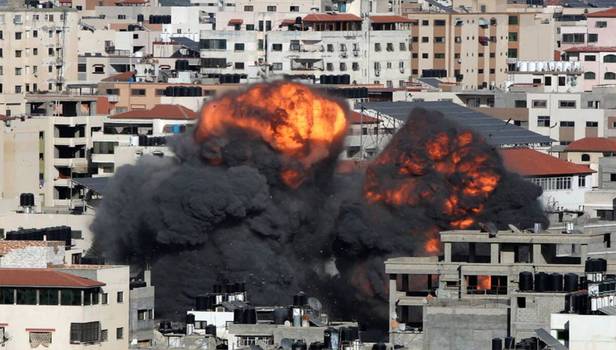Establishment of Israel in Palestine: Fall of Palestine, Rise of Israel
18 May 2021 ( IBTN News Bureau )
The conflict between Israel and Palestinian fighters has begun once more. The level of shelling that is being seen this time, it did not happen in the last several years.
Palestinian extremists have fired several hundred rockets from the Gaza Strip into the territory of Israel, and Israel has responded to this by its devastating airstrikes.
The target of rockets fired by Palestine is Israeli cities like Tel Aviv, Modine, Birsheba. Israel's missile defense system is responding to attacks by the Iron Dome Palestinian side. But the ringing of the sirens of danger has not stopped yet.
Israel has carried out airstrikes at several Gaza locations. There has been loss of life and property on both sides. Dozens of Palestinians have been killed, while on the other hand at least 10 Israelis have died.
This armed conflict has started after weeks of tension between Israeli police and Palestinian protesters in Jerusalem. Jerusalem is a place that is considered sacred to Jews and Muslims around the world.
The international community has appealed to both sides to maintain peace. In the Middle East, UN peace envoy Tor Vainsland has said that there is a danger of large-scale fighting there.
But the struggle of Israel and Palestinian people is years old and should be viewed from the same perspective. Why is the dispute between Israelis and Palestinians so complicated and why is the world divided about it? To understand this, we need to know the history of Israel and Palestine.
How did the conflict begin?
Jews were being targeted in Europe in the early twentieth century. Under these circumstances, the demand for a separate country for the Jewish people began to gain momentum. The region of Palestine, which lies between the Mediterranean Sea and the Jordan River, was considered sacred to all three Muslims, Jews and Christianity. Palestine was controlled by the Ottoman Empire and was largely held by the Arabs and other Muslim communities.
Amidst all this, a large number of Jews came to settle in Palestine and the people of Palestine started protesting against them.
After the First World War (1914–1918) the Ottoman Empire (the Kingdom of Osmania) disintegrated and Britain got the approval of the United Nations to take the administration of Palestine under its control.
But before the First World War and during the fighting, the British had made many promises to the Arabs and the Jewish people in Palestine, which they could not fulfill even a small part. Britain had already partitioned the Middle East with France. This led to tensions between the Arab people and Jews in Palestine and triggered violent clashes between armed groups on both sides.
After World War II (1939–1945) and the widespread massacre of Jews at the hands of Hitler and the Nazis in Germany, there was increasing pressure on the demand for a separate country for Jews. At that time it was planned that the territory under British control would be divided between the Palestinians and the Jews.
Finally, on 14 May 1948, with the help of Britain, Israel was forcibly established in Palestine. And Palestine was annihilated by the Jews. With the formation of Israel, a local tension turned into a territorial dispute. The very next day Egypt, Jordan, Syria and Iraq attacked this area. This was the first Arab-Israel conflict. It was also called the alleged freedom struggle of the Jews. After the end of this war, the United Nations secured half the land for an Arab state.
The period of tragedy started for the Palestinians from there itself. Seven and a half million Palestinians had to flee or take refuge in neighboring countries or were expelled and evicted by the Jewish armed forces.
But the year 1948 was not the last conflict between Jews and Arabs. In the year 1956, there was a dispute over the Suez Canal and Israel and Egypt again stood opposite each other. But this matter was resolved without war.
But the Arab-Israeli conflict lasted for six days in 1967 was the last major battle in a way. The war between 5 June 1967 and 10 June 1967 saw long-term effects on many levels.
Israel won the military alliance of the Arab countries. The Gaza Strip, Egypt's Sinai Peninsula, Jordan to the West Bank (including East Jerusalem) and the Golan Mountains from Syria came under the control of Israel. Five lakh Palestinians were displaced.
The last Arab-Israel conflict was the Yom Kippur War of 1973. Egypt and Syria fought this war against Israel. Egypt regained the Sinai Peninsula. In the year 1982, Israel gave up its claim on the Sinai Peninsula but not on Gaza. Six years later Egypt became the first Arab country to have a peace deal with Israel. Jordan followed suit.
Why was Israel established in the Middle East?
The Jews believe that this is the area where Israel is inhabited today, which God promised to give to Abraham and his descendants, their first ancestors.
In the past, this area was under attack from Assyrians (the tribal people living in present-day Iraq, Iran, Turkey and Syria), Babylon, Persia, Macedonia and Roman people. In the Roman Empire itself, this area was named Palestine, and seven decades after Christ, the Jewish people were evicted from this area.
With the rise of Islam, Palestine came under the control of the Arabs in the seventh century and was then conquered by the European invaders. In the year 1516, Palestine went under the control of the Ottoman Empire (Osmania Empire) and then after the First World War, on 29 September 1923, Britain occupied Palestine. Which lasted until May 15, 1948, the day after the founding of Israel on May 14, 1948.
To allow a smooth transition of power after 15 May 1948, Britain as a mandatory power was to hand over the UN Palestine Commission as the Provisional Government of Palestine.
On September 3, 1947, a United Nations Special Committee on Palestine submitted its report to the General Assembly. In this report, the committee accepted religious and historical arguments for the establishment of a Jewish nation in the Middle East.
In the Balfour Declaration of 1917, the British Government agreed to give Jews a 'national house' in Palestine. The Declaration recognized the historical connection of the Jewish people with Palestine and based on this, laid the foundation of the Jewish state in the territory of Palestine.
After the genocide of millions of Jews at the hands of the Nazis in Europe and during World War II, international pressure to recognize a separate Jewish nation began to increase.
Britain took up this issue for the consideration of the United Nations after failing to resolve the growing tension between the Arab people and the Jews.
On 29 November 1947, the United Nations General Assembly approved the plan for partition of Palestine. It recommended the formation of an Arab country and a Jewish state, as well as a special arrangement for Jerusalem.
This plan was accepted by the Jews but rejected by the Arab people. They saw it as losing their land. This was the reason why the United Nations plan could never be implemented.
The formation of independent Israel was announced on May 14, 1948, the day before Britain's control over Palestine came to an end. The next day, Israel applied for UN membership, and a year later it was approved. Among the member countries of the United Nations, 83 percent of the countries have recognized Israel. As of December 2019, 162 of 193 countries had recognized Israel.
Why are there two Palestinian territories?
The United Nations Special Committee on Palestine submitted a report to the General Assembly in 1947, recommending that the Western Galley (the mountainous region of Samaria and Judea) be included in the Arab nation.
The committee had recommended keeping the coastal plain of Ishud bordering Jerusalem and Egypt out of it.
But the division of this region was defined by the Armaistice line drawn in the year 1949. This line was drawn after the formation of Israel and the first Arab-Israeli War.
These two regions of Palestine are the West Bank (which includes East Jerusalem) and the Gaza Strip. These two areas are at a distance of 45 km from each other. The area of the West Bank is 5970 square kilometers, while the area of the Gaza Strip is 365 square kilometers.
The West Bank lies between Jerusalem and the eastern part of Jordan. Jerusalem is described by both the Palestinian side and Israel as its capital.
The Gaza Strip is a 41 km long area, whose width varies between 6 to 12 km.
Gaza has a 51-km border with Israel, seven kilometers with Egypt and 40 kilometers along the Mediterranean coast.
The Gaza Strip was taken over by Israel in the 1967 war. In 2005, Israel relinquished its hold on it. However, Israel controls the influx of people, goods and services from the Gaza Strip to air, land and sea in every way.
The Gaza Strip is currently a territory controlled by Hamas. Hamas is Israel's armed group that does not recognize Israel's pact with other factions of Palestine.
In contrast, the West Bank is ruled by the Palestinian National Authority. The Palestinian National Authority recognizes the international community as the government of the Palestinians.
Has there ever been an agreement between the Palestinians and the Israelis?
After the formation of Israel and the displacement of thousands of Palestinians, the Palestinian movement began to take root in refugee camps in the West Bank, Gaza, and Arab countries.
This movement had the support of Jordan and Egypt.
After the 1967 war, Palestinian organizations such as 'Fatah' led by Yasir Arafat formed the 'Palestinian Liberation Organization'.
The PLO initiated action against Israel, first from Jordan and then from Lebanon.
But these attacks targeted all targets within and outside Israel. There was no discrimination between Israel's embassies, players, its airplanes.
The Israeli targets were attacked for years by the Palestinians, and finally in 1993, the Oslo Peace Accord was signed by the PLO and Israel.
The Palestinian Liberation Organization promised to abandon the path of 'violence and extremism' and accepted Israel's right to live with peace and security. However, Hamas does not accept this agreement.
After this agreement, the Palestinian National Authority was formed and this organization got the right to represent the Palestinian people on international forums.
The president of this organization is elected by direct voting. The Chairman appoints a Prime Minister and his Cabinet. It has the authority to manage civic amenities in urban and rural areas.
East Jerusalem, historically considered the capital of the Palestinians, was not included in the Oslo peace settlement.
There is a deep dispute between the two sides regarding Jerusalem.
What are the main points of dispute between the Palestinians and the Israelis?
The delay in the formation of an independent Palestinian nation, the settlement of the ghettos in the West Bank and the security cordon surrounding the Palestinian territory are the reasons that hamper the peace process.
The International Court of Justice in The Hague has also criticized Israel's security cordon around the Palestinian territory.
In 2000, when the last serious effort was made to reconcile between the two sides in the presence of President Bill Clinton at Camp David in the US, it was clear that this is not the only obstacle in the path of peace between the Palestinians and the Israelis. .
At the time, Bill Clinton had failed to reach a compromise between Israeli Prime Minister Ehud Barak and Yasir Arafat. The issues on which there was disagreement between the two sides were the issue of Jerusalem, the border and land, the ghettos and Palestinian refugees.
Israel claims that Jerusalem is its territory. It says that since the capture of East Jerusalem in 1967, Jerusalem has been its capital, but it is not recognized internationally. The Palestinian side wants East Jerusalem to be its capital.
The Palestinians demand that the Arab-Israeli war that lasted six days, or the situation before June 4, 1967, determine its boundaries, which Israel refuses to accept.
Jewish settlements have been settled by Israel on occupied lands. They are illegal under international laws. More than half a million Jews live in these settlements in the West Bank and East Jerusalem.
The actual number of Palestinian refugees depends on who counts it. The PLO says that their number is more than one crore. Half of these people are registered with the United Nations. The Palestinians say that these refugees have the right to return to their land. But the land they are talking about is Israel today, and if that happens, what will happen to its identity as a Jewish nation.
Is Palestine a Country?
The United Nations recognizes Palestine as a 'non-member-observer state'.
The Palestinians have the right to participate in General Assembly meetings and debates to improve their chances of subscribing to UN organizations.
In 2011, Palestine applied for full membership but it did not happen.
More than 70% of the United Nations General Assembly members recognize Palestine as a state.
Why is America the main partner of Israel? Who has the support of Palestine?
For this, the importance of the pro-Israel vigorous lobby in America has to be understood. Public opinion in the US also supports Israel's stand.
Therefore, it is virtually impossible for a US president to withdraw support from Israel.
Apart from this, both countries are also military allies. Israel has received the most help from the United States. This help comes in the form of arms purchases and money.
However, in 2016, when the Security Council was voting on criticism of Israel's Jewish settlements policy, the Obama administration did not exercise its veto power.
But after the arrival of Donald Trump in the White House, the relationship between the two countries got new life. The US moved its embassy from Tel Aviv to Jerusalem. With this, America became the first country in the world to recognize Jerusalem as the capital of Israel.
In the last days of his term, President Trump was successful in normalizing Israel's relations with wealthy Arab countries.
However, since the Biden administration took power, Israel has adopted a strategy to distance itself from the risky conflict in Palestine. Experts say that the Biden administration sees this as a problem that requires huge political capital and what will be achieved is not sure.
US support to Israel continues, but the Biden administration's diplomacy appears to be a precaution. However, after the current violence, Biden may face criticism from his party's left wing, which have been critical of Israel.
On the other hand Turkey, Pakistan, China, India, Malaysia, Saudi Arabia, United Arab Emirates, Egypt, Syria, Iran and many Arab countries are with Palestinian people on the issue of Palestine. There is a feeling of sympathy for the Palestinians in Arab countries.
What is the way to peace and what needs to be done for it?
Experts say that for permanent peace, Israel should accept the sovereignty of the Palestinians, including Hamas. He should end the blockade with Gaza and also lift restrictions in the West Bank and East Jerusalem.
On the other hand, Palestinian factions have to abandon the path of violence for permanent peace and accept Israel.
Both sides have to reach an acceptable agreement on the issue of borders, Jewish settlements and the return of Palestinian refugees.
(Click here for Android APP of IBTN. You can follow us on facebook and Twitter)
Share This News
About sharing
-
 19 Apr 2025
Meme warfare in Trump’s battle with Beijing
19 Apr 2025
Meme warfare in Trump’s battle with Beijing
Meme warfare in Trump’s battle with Beijing
Saturday, Apr ...
-
 11 Apr 2025
Gaza is a post-apocalyptic killing zone: UNRWA chief Philippe Lazzarini
11 Apr 2025
Gaza is a post-apocalyptic killing zone: UNRWA chief Philippe Lazzarini
Gaza is a post-apocalyptic killing zone: UNRWA chief Philippe Lazzarini
-
 11 Apr 2025
Ralph Wilde on the ICJ & why Israeli occupation must end?
11 Apr 2025
Ralph Wilde on the ICJ & why Israeli occupation must end?
Ralph Wilde on the ICJ & why Israeli occupation must end?
Fr...
-
 10 Apr 2025
Can Europeans alone change the course of Russia's war in Ukraine?
10 Apr 2025
Can Europeans alone change the course of Russia's war in Ukraine?
Can Europeans alone change the course of Russia's war in Ukraine?
... -
 10 Apr 2025
What is behind Trump's U-turn on tariffs?
10 Apr 2025
What is behind Trump's U-turn on tariffs?
What is behind Trump's U-turn on tariffs?
Thursday, Apr 10, ...



